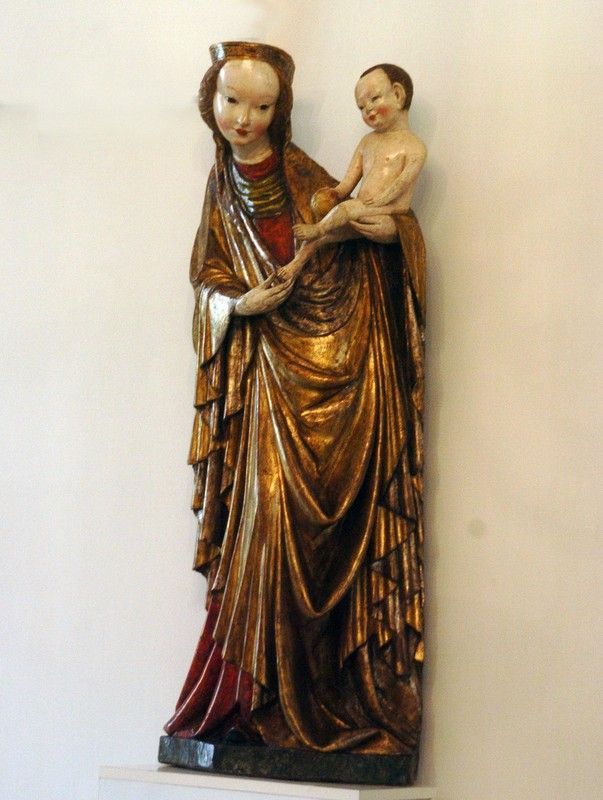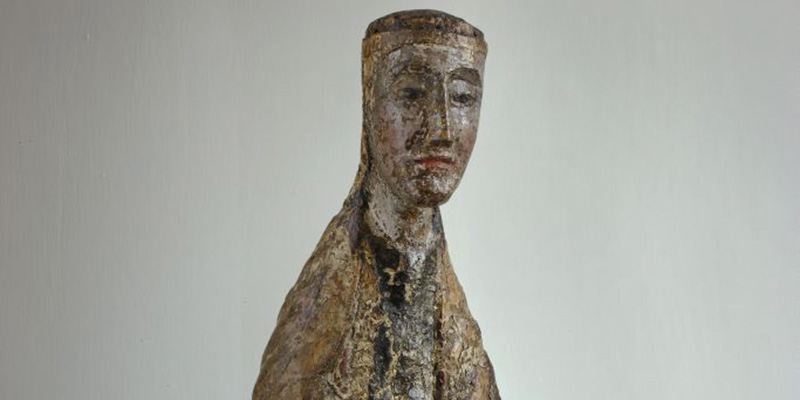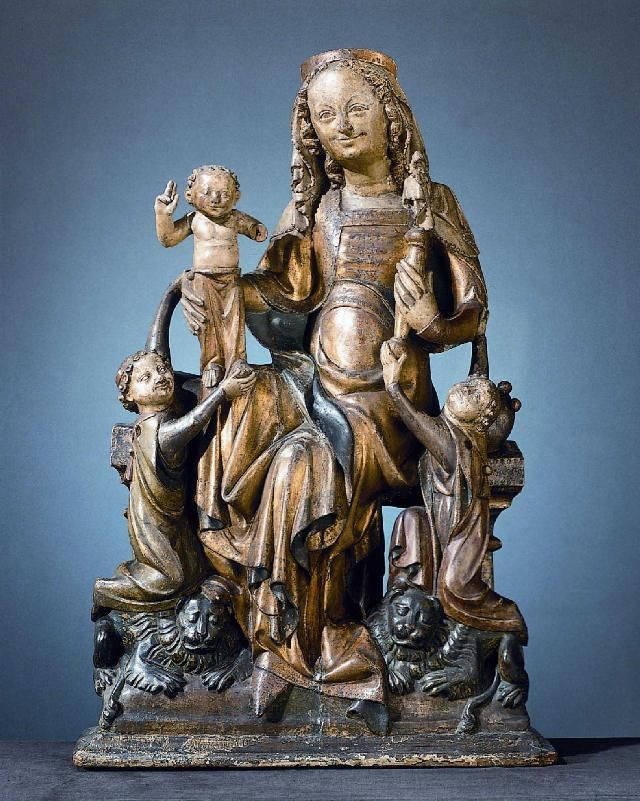Poland’s Most Beautiful Mediaeval Madonnas
You may have heard about the Black Madonna of Częstochowa, but how about the Madonna of Skarbimierz enthroned on lions? Or the Shrine Madonna of Klonówka? And did you know that the oldest Polish religious statue is also a figure of the Virgin Mary? Meet five incredible Polish Madonnas.
The Beautiful Madonna from Wrocław
Embeded gallery style
display gallery as slider
International Gothic, a period of art which spread across Europe in the late 14th and early 15th centuries, saw the development of the so-called Beautiful Style, also known as the Beautiful Madonnas, each of them a standing figure of the Virgin Mary with the Baby Jesus in her arms. Mary’s physical beauty, widely described in theological treatises, is a reflection of the spiritual beauty befitting the Mother of God.
One of the style’s most prominent examples is the Beautiful Madonna from Wrocław. This limestone figure in a high crown stands in a studied pose, while she gives an apple to her son. The Holy Child, held by the Virgin Mary, takes it carefully, with fear discernible in both his face and pose. Mary’s richly adorned robes can be a reference to the concept of Mary as Our Lady of Charity, who intercedes to God for sinful mankind. The white colour of the cloak represents the white robes of the saved in The Book of Revelations, while red symbolizes the blood shed by the Saviour. The apple, on the other hand, stands for Christ’s sacrifice on Golgota. Thus, Mary becomes the new Eve, and through her humble consent to the Incarnation she reforms Eve’s disobedience, which brought the Original Sin upon humanity.
The Madonna of Krużlowa
 Madonna of Krużlowa, ca 1400-1410, from the collection of the National Museum in Kraków, Bishop Erazm Ciołek Palace, photo: Wacław Klag / Dziennik Polski / Reportre / East News
Madonna of Krużlowa, ca 1400-1410, from the collection of the National Museum in Kraków, Bishop Erazm Ciołek Palace, photo: Wacław Klag / Dziennik Polski / Reportre / East NewsThe most famous medieval statue from Poland, the Madonna of Krużlowa was probably sculpted between 1400 and 1410. It adorned Krużlowa parish – the seat of the prestigious brotherhood of Catholic priests who came to evangelize the area, then under Ruthenian and Orthodox influences. The wooden sculpture features Madonna’s beautiful girlish face and slender body clad in a fantastically draped robe. In her arms, she holds the Baby Jesus, who places his left hand on his leg and in his right hand holds a round fruit, probably an apple. Their faces are brightened by delicate smiles.
The sculpture is considered one of the best examples of International Gothic in Polish collections.
The Madonna of Ołobok
 The Madonna of Ołobok, detail, late 12th/ early 13th century, polychrome on linden wood, National Museum in Warsaw’s collection, photo: MNW
The Madonna of Ołobok, detail, late 12th/ early 13th century, polychrome on linden wood, National Museum in Warsaw’s collection, photo: MNWProbably the oldest wooden cult statue preserved in Poland, the Madonna of Ołobok comes from the second half of the 12th century or the beginning of the 13th century. Although significantly tarnished, it still shows its high artistic quality. Mary’s figure, seated on a low throne, strikes with its disproportions: between its short legs and slender torso and between its softly-sculptured head and the crude form of the rest of the figure. The statue references the theological concept of Sedes Sapientiae, the Throne of Wisdom, characteristic of early medieval liturgy. It symbolizes the idea of Mary as the throne for the Incarnated Logos (Christ), in accordance with the dogma of the Mother of God, adopted by the Council of Ephesus in 431.
The Shrine Madonna of Klonówka
Embeded gallery style
display gallery as slider
The shrine statue from Klonówka belongs to a rather exclusive group – there are only 45 known shrine sculptures of the Virgin Mary, made of an array of materials: ivory, silver, gold and wood. Here, the outside of the sculpture depicts the Baby Jesus sitting on Mary’s right knee. A division in the centre of the figure creates two moving parts, which, upon opening, show the Holy Trinity in the Throne of Mercy scene: the enthroned Father, depicted as an old man, opens his hands as if holding his crucified Son.
The Klonówka statue was sculpted in the late 14th century under the influence of the Teutonic Order. Currently, the sculpture belongs to the collection of the Diocesan Museum in Pelplin.
The Madonna of Skarbimierz
 Master of Madonnas on Lions, Madonna of Skarbimierz,
Master of Madonnas on Lions, Madonna of Skarbimierz,
circa 1350-1360, National Museum in Wrocław’s collection,
photo: National Museum in WrocławThe Madonna on Lions is one of the most interesting late medieval art phenomena from Central Europe. One of its earliest examples is the Madonna of Skarbimierz, created around 1350-1360. The sculpture depicts Maria in the splendour of royal power: in a crown, wielding a sceptre and clad in a golden cloak. The Baby Jesus standing on her knee blesses the faithful. Mother and Son are joined by two angels, who, kneeling on the backs of lions, support the divine figures. Everyone is smiling, including the lions!
The lion motif has been interpreted in different ways: it could be a reference to the Old Testament description of the wise king Solomon. The fact that Mary rests her foot on the back of a lion is said to symbolize a kind of a genealogical ‘accession’ of Mary into the lineage of Christ, descendant of David – the new Lion of Judah.
Source: Culture.pl's material, compiled by PW, translated by OK
Embeded gallery style
display gallery as slider
[{"nid":"5688","uuid":"6aa9e079-0240-4dcb-9929-0d1cf55e03a5","type":"article","langcode":"en","field_event_date":"","title":"Challenges for Polish Prose in the Nineties","field_introduction":"Content: Depict the world, oneself and the form | The Mimetic Challenge: seeking the truth, destroying and creating myths | Seeking the Truth about the World | Destruction of the Heroic Emigrant Myth | Destruction of the Polish Patriot Myth | Destruction of the Flawless Democracy Myth | Creation of Myths | Biographical challenge | Challenges of genre | Summary\r\n","field_summary":"Content: Depict the world, oneself and the form | The Mimetic Challenge: seeking the truth, destroying and creating myths | Seeking the Truth about the World | Destruction of the Heroic Emigrant Myth | Destruction of the Polish Patriot Myth | Destruction of the Flawless Democracy Myth | Creation of Myths | Biographical challenge | Challenges of genre | Summary","topics_data":"a:2:{i:0;a:3:{s:3:\u0022tid\u0022;s:5:\u002259609\u0022;s:4:\u0022name\u0022;s:26:\u0022#language \u0026amp; literature\u0022;s:4:\u0022path\u0022;a:2:{s:5:\u0022alias\u0022;s:27:\u0022\/topics\/language-literature\u0022;s:8:\u0022langcode\u0022;s:2:\u0022en\u0022;}}i:1;a:3:{s:3:\u0022tid\u0022;s:5:\u002259644\u0022;s:4:\u0022name\u0022;s:8:\u0022#culture\u0022;s:4:\u0022path\u0022;a:2:{s:5:\u0022alias\u0022;s:14:\u0022\/topic\/culture\u0022;s:8:\u0022langcode\u0022;s:2:\u0022en\u0022;}}}","field_cover_display":"default","image_title":"","image_alt":"","image_360_auto":"\/sites\/default\/files\/styles\/360_auto\/public\/2018-04\/jozef_mroszczak_forum.jpg?itok=ZsoNNVXJ","image_260_auto":"\/sites\/default\/files\/styles\/260_auto_cover\/public\/2018-04\/jozef_mroszczak_forum.jpg?itok=pLlgriOu","image_560_auto":"\/sites\/default\/files\/styles\/560_auto\/public\/2018-04\/jozef_mroszczak_forum.jpg?itok=0n3ZgoL3","image_860_auto":"\/sites\/default\/files\/styles\/860_auto\/public\/2018-04\/jozef_mroszczak_forum.jpg?itok=ELffe8-z","image_1160_auto":"\/sites\/default\/files\/styles\/1160_auto\/public\/2018-04\/jozef_mroszczak_forum.jpg?itok=XazO3DM5","field_video_media":"","field_media_video_file":"","field_media_video_embed":"","field_gallery_pictures":"","field_duration":"","cover_height":"991","cover_width":"1000","cover_ratio_percent":"99.1","path":"en\/node\/5688","path_node":"\/en\/node\/5688"}]